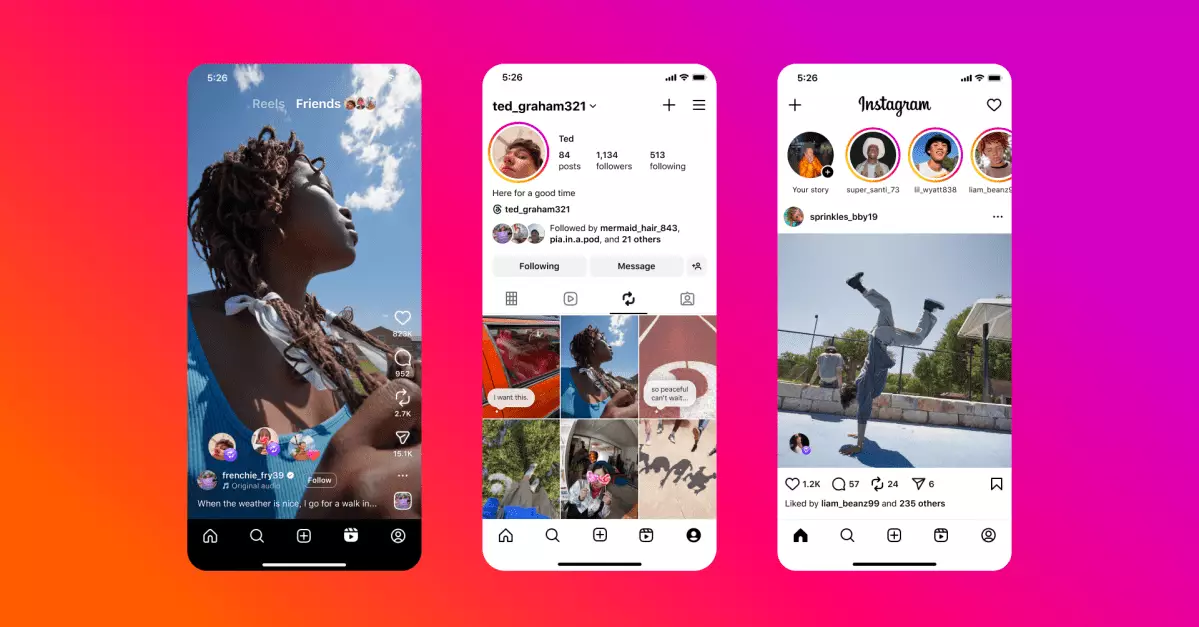In the ever-evolving landscape of social media, Instagram’s latest move to incorporate a TikTok-inspired repost feature signifies a pivotal shift in its content-sharing paradigm. Historically, Instagram centered around a visual diary of personal photos and curated images shared primarily with friends and family. However, recent years have seen the platform drift away from this initial purpose, favoring algorithm-driven recommendations and fleeting Reels that prioritize viral trends over genuine connections.
By introducing the ability to repost public Reels and grid posts directly onto a user’s profile, Instagram attempts to strike a delicate balance: embracing new content formats while cautiously returning to its roots of personal sharing. Unlike the ephemeral nature of Stories, this feature promises permanence and visibility, positioning reposts as integral parts of a user’s content identity. It hints at an understanding that community engagement isn’t solely driven by original content but also by acknowledging and amplifying others’ contributions. This shift could foster more meaningful interactions—users can now curate a mosaic of the content they appreciate or want to spotlight, creating a richer storytelling experience that goes beyond static images.
Nevertheless, it begs the question: will this feature be enough to rekindle Instagram’s original charm? The platform has, in recent years, morphed into a battleground dominated by TikTok-style short videos, often at the expense of the personal touch that defined early days. Reposting could serve as a corrective, a way to celebrate community-driven content instead of isolated influencer narratives. But if mishandled, it risks becoming a cluttered feed of recycled content, diluting individual voices and making the user experience feel less authentic.
Strategic Borrowing or Missed Opportunities? The Danger of Cloning Competitors
While drawing inspiration from TikTok’s repost mechanism seems a logical step to stay competitive, it raises concerns about Instagram’s ability to differentiate itself in a crowded market. The platform has consistently borrowed features from competitors—be it stories from Snapchat or short-form videos from TikTok. The addition of the repost feature appears to be an attempt to capitalize on TikTok’s success in fostering viral trends.
However, simply mimicking features without a clear vision risks commodifying Instagram’s unique appeal. TikTok’s repost functionality fosters a vibrant creator economy by making content easy to share and remix, fueling vibrant trends and community participation. For Instagram to truly benefit, it must not only implement this feature but also weave it into a broader narrative that revitalizes its identity as a place for both discovery and genuine connections.
Furthermore, with the recent introduction of a dedicated “reposts” tab, Instagram signals a desire to make curated content more accessible, yet this could lead to clutter if users aren’t strategic. The challenge lies in encouraging meaningful sharing without turning the feed into a disorganized jumble of repurposed posts.
Enhanced Privacy and Control: Addressing Long-standing User Concerns
Another critical component of Instagram’s updates pertains to transparency and user control, especially regarding the “activity” tab that reveals friends’ interactions. When initially rolled out, the feature sparked privacy concerns, as users felt exposed and their engagement habits scrutinized. By expanding controls—allowing users to hide their likes and reposts and mute other users’ activity—Instagram demonstrates a recognition of its user base’s desire for discretion.
This shift toward greater privacy controls may help mitigate user discomfort, encouraging more authentic engagement. It presents an opportunity for the platform to rebuild trust, but only if executed with sensitivity. Overly intrusive sharing modes may continue to alienate users who prefer intimate, private connections over public displays of activity.
Moreover, the integration of a Snap Map-like feature, showing last active locations and content from popular spots, could significantly alter how users experience the platform. While it offers the promise of real-time community connection, it also carries privacy risks. If not carefully managed, it could lead to discomfort or even safety concerns. To succeed, this feature must be implementable with opt-in controls and clear privacy settings, aligning with users’ increasing demand for moderation over their digital footprints.
Reclaiming Its Core: Can New Features Rejuvenate Instagram’s Purpose?
Ultimately, Instagram’s ongoing experiments may be a frantic attempt to stay relevant amidst fierce competition. Reels, suggested algorithms, location maps—all are attempts to adapt to user preferences but often come at the cost of diluting the platform’s original intimacy and personal connection ethos.
The real challenge now lies in balancing innovation with authenticity. Will these new features foster a space where users feel empowered to share meaningfully? Or will they deepen the erosion of Instagram’s core identity, transforming it into a superficial content factory? The platform’s trajectory depends heavily on how well it can integrate these features into a cohesive user experience that values genuine interaction over sheer view counts.
In my opinion, Instagram’s future hinges on its ability to innovate without losing sight of the intimacy and community it was built upon. The latest updates are steps in the right direction, but only if they serve to reinforce trust and authenticity rather than simply mimicking competitors. The platform has the potential to redefine social sharing once again—if it learns to prioritize quality over quantity, connection over competition.

